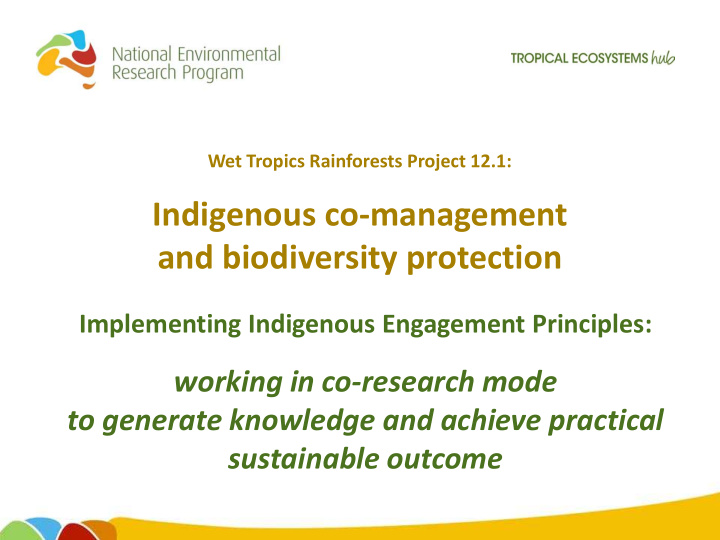



Wet Tropics Rainforests Project 12.1: Indigenous co-management and biodiversity protection Implementing Indigenous Engagement Principles: working in co-research mode to generate knowledge and achieve practical sustainable outcome
THE WORK • Brings management institutions and Traditional Owners together as a collaborative co-research team • Shares knowledges and explores different views of managing country • Looks at how management arrangements can better recognise traditional knowledge, culture and practices, and progress stronger (co- / collaborative / joint) management of conservation areas • Understand institutions, opportunities and structural barriers • Identify and bridge gaps • Provide input into policy options and management practice.
RESULTS Part One: Institutional analysis (Maclean et al. 2012) Institutions as the formal and informal arrangements, rules, regulations and social norms that shape behaviour • International, national, state, regional, local • Regulatory vs non-regulatory The extent to which each institution considers the rights, values and roles of Aboriginal people in environmental management Identified significant barriers exist to equitable engagement
Level Regulatory/ Organisations Rights Cultural Roles in RESULTS Non-regulatory (native title) Values Biodiversity Management Global 1 regulatory Four United 2 no, 4 yes 6 yes 1 no, 5 yes 5 non-regulatory Nations organisations National 3 regulatory, 1 3 Australian 4 yes 4 yes 2 yes, 2 no non-regulatory Government organisations State 11 regulatory Multiple State 12 yes 8 yes, 3 no, 6 yes, 4 no, 2 (Queensland) 1 non-regulatory agencies 1 unclear unclear Diverse Regional 5 regulatory 14 yes, 1 no, 1 14 yes, 2 no 15 yes, 1 no government, non- 11 non- unclear (both (regulatory) government, regulatory regulatory) Indigenous organisations Diverse Local 2 regulatory, 3 5 yes 4 yes, 1 site- 4 yes, 1 site government, non- non-regulatory specific specific government, Indigenous organisations
RESULTS Part Two: Looked at Indigenous views of co-management a process of Indigenous societies’ strategic leadership and rights and responsibility-based engagement
Part Three: Joint Workshop RESULTS Indigenous co-management as a process of emergent path-generation towards a new equitable relationship
APPLICATION OF WORK FUTURE DIRECTIONS Participatory evaluation of Rainforest Aboriginal people, government agencies and current status of Indigenous community organisations in the Wet engagement in the wet tropics Tropics region using the outcomes against the frameworks of this research to strengthen their Identifying gaps between collaboration in ensuring effective sustainable management of these aspirations and current levels landscapes…….. of engagement and policy options to bridge these The principles emerging from the Policy and mechanisms for research will likely to be relevant throughout Australia. engaging Indigenous knowledge and values for effective joint management
THANK YOU RAP Vinc e Mund ra b y, Phil Rist, Mic ha e l F rid a y, Ro b yn Be lla fq uih, L isa Sa ra g o , Jo a nn Sc hmid e r Ro Hill, Pe tina Pe rt, K CSIRO irste n Ma c le a n, L e a h T a lb o t WT MA Nig e l He d g c o c k T e rra in NRM Da vid Hinc hle y, Ste ve Mc De rmo tt RAIN Pty L td E llie Bo c k (c o nse rva tio n se c to r) DNPRSR Bruc e Ra mpto n AIAT SI S T o ni Ba uma n SE WPAC Sha un Ba rc la y, Go rd o n Jo hnsto n Bro ade r RAP c o mmunity, land manag e rs and re se arc he r partic ipants
Recommend
More recommend